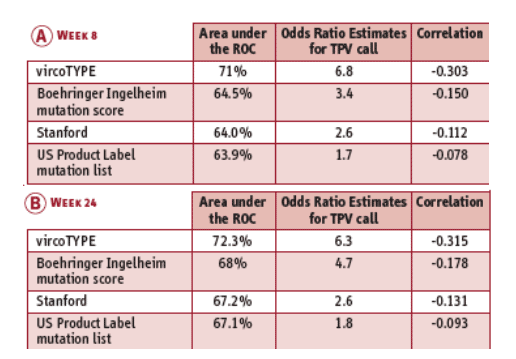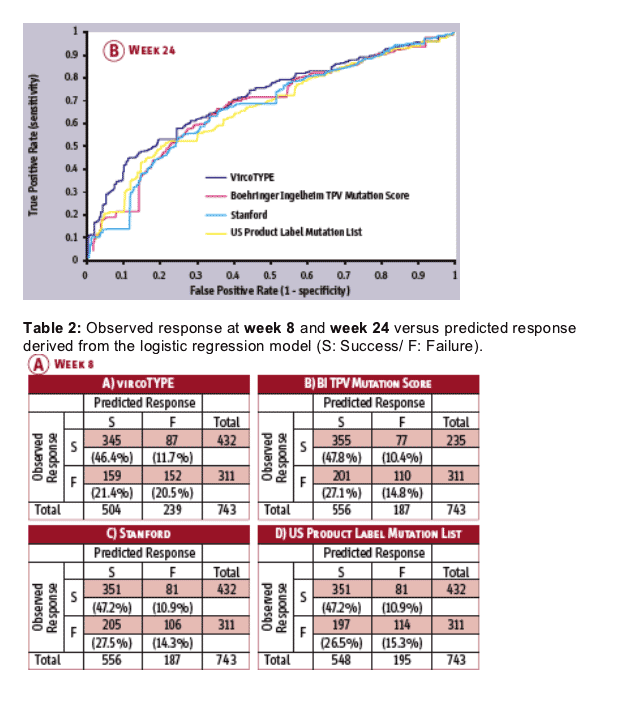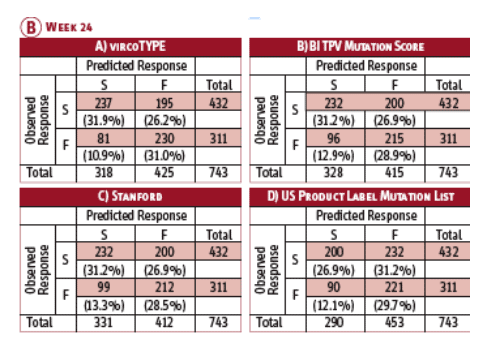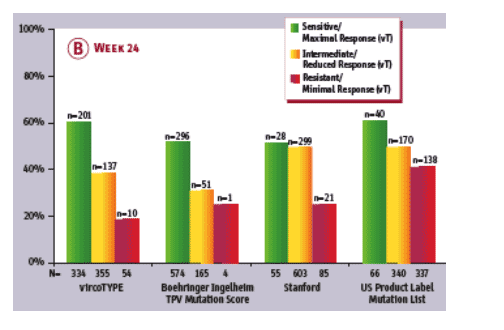 |
 |
 |
| |
Correlation of Resistance Algorithms for Tipranavir Susceptibility with Response to Tipranavir Containing Regimens in the RESIST Trials
|
| |
| |
Reported by Jules Levin
5th European HIV Drug Resistance Workshop
Koen Van der Borght1, Bart Winters1, Elke Van Craenenbroeck1, Virginie Braido1, Lee Bacheler2, Veronika Kohlbrenner3, David Hall3 and Jorge Villacian1
1:Virco BVBA, Mechelen, BE; 2:Vircolab, Inc, Durham, NC, USA, 3:Boehringer Ingelheim, Ridgefield Conn, USA
BACKGROUND
A variety of resistance algorithms are available to interpret resistance to the new PI tipranavir (TPV). We compared the performance of three genotypic algorithm-based scores to phenotypic resistance based scores (derived from vircoTYPE-HIV-1) in predicting response to TPV containing regimens in the multi-experienced patient population participating in the RESIST studies.
METHODS
The resistance call for TPV by each interpretation system analyzed (Stanford (version 4.2.6), TPV mutation score developed by Boehringer Ingelheim (VM Kohlbrenner et al., 13th International HIV Drug Resistance Workshop, Tenerife,
Spain), PI mutation list presented in the US Product Label, and vircoType (version 4.0.01)) was correlated with the clinical outcome data from the RESIST studies. The TPV mutation score by Boehringer Ingelheim involved the following PI mutations: 10V, 13V, 20M/R/V, 33F, 35G, 36I, 43T, 46L, 47V, 54A/M/V, 58E, 69K, 74P, 82L/T, 83D, 84V. The mutation list by the US product label involves any mutation at the following positions: 30, 32, 36, 46, 47, 48, 50, 53, 54, 82, 84, 88 or 90.
In order to standardize the interpretation of backbone activity to compare only the prediction of TPV, the activity of the drugs used in combination with TPV was scored by a continuous phenotypic sensitivity score (cPSS) calculated as the sum of the activities of each drug in the backbone (1 if FC < vircoTYPE clinical cutoff 1(CCO1), 0 if FC > CCO2, linear interpolation between 1 and 0 if FC between clinical cut-offs).
The resistance interpretation for TPV by each of the interpretation systems was combined with the activity of the backbone in one model predicting clinical outcome.
A responder was defined as a patient having reached a 1 log drop in viral load or below the detection limit of the viral load test kit at 8 and/or 24 weeks. Patients dropping out before the 24 week evaluation were considered nonresponders.
The association of baseline sensitivity scores with virologic outcome to the TPV containing regimens was evaluated using 4 metrics
Baseline sensitivity scores, calculated as the sum of the TPV call by the respective algorithm and the cPSS of the backbone by vircoTYPE, were correlated with viral load drop at weeks 8 and 24 using Spearman correlation. Dropouts at week 24 were treated as missing for this analysis.
Baseline sensitivity scores were correlated with response rate at weeks 8 and 24 using logistic regression accuracy (area under the ROC curve) and odds ratio based on a logistic regression model including the cPSS of the backbone and the resistance call of TPV by the respective algorithm. This resulted in 4 similar models differing only in the TPV interpretation:
Model 1:
Clinical outcome = TPV Call by vircoTYPE + cPSS of backbone
by vircoTYPE
Model 2:
Clinical outcome = TPV Call by US Product Label + cPSS of backbone by vircoTYPE
Model 3:
Clinical outcome = TPV Call by Stanford + cPSS of backbone
by vircoTYPE
Additionally, the proportion of patients correctly classified as responders or non-responders was evaluated using a logistic regression model including the cPSS of the backbone and the resistance call of TPV by the respective algorithm.
RESULTS
Of the interpretation methodologies evaluated, the TPV resistance call based on vircoTYPE predicted FC was most strongly associated with virologic response at week 8 and at week 24 (Table 1 below) [accuracy: 71% (vircoType), 64.5% (TPV score), 64% (Stanford), and 63.9% (mutation list), Spearman R: 0.30 (vircoType), to 0.07 (mutation list)]; and week 24 [accuracy: 72.3% (vircoType), 68% (TPV score), 67.2 (Stanford), and 67.1%(mutation list); Spearman R: 0.31 (vircoType) to 0.09 (PI mutation list)]. Number of patients correctly assigned (out of 743) at week 8 ranged from 474 (mutation list) to 527 (vircoType), and at week 24: 498 (mutation list) to 537 (vircoType).
DISCUSSION
There are currently several different methods for interpreting resistance to antiretroviral agents. With the development of new generation Protease Inhibitors, it has become apparent that a higher number of mutations and mutation interactions play a role in decreasing susceptibility to the drug. We have analyzed the accuracy of different methods in interpreting resistance to the new PI tipranavir. In order to highlight the contribution of the tipranavir call to the response prediction, background regimen activity was scored by a consistent approach which used a cPSS calculation based on the vircoTYPE analysis.
CONCLUSIONS
The use of a cPSS based on resistance interpretation by vircoTYPE for predicting response to antiretroviral regimens containing TPV in multi experienced patients provided the best accuracy and correlation with treatment response.
This was observed when performing the comparisons either at week 8 or week 24 after treatment initiation.
All differences observed are due to TPV resistance interpretation based on the different methodologies utilized since background regimen activity was assessed in a consistent way.
While vircoTYPE CCOs are based on week 8 outcome data, the good correlation with virologic response persisted through 24 weeks which is a more relevant timepoint for achieving a sustained and durable treatment response.
The better performance of a predicted phenotype approach could be due to the ability of this method to factor complex mutational profiles in its resistance interpretation and more accurately predict expected activity of drugs against viruses with varying degrees of drug resistance. Among the genotypic algorithms evaluated, the Boehringer Ingelheim TPV mutation score provided the best performance.
Table 1: Area under the ROC curve, odds ratio of being a responder in the sensitive class as compared to the resistant class and Spearman correlation coefficient for each of the algorithms included in the analysis at week 8 (a) and week 24 (b) (N=743).

Figure 1: Receiver-Operator Characteristic curves for the interpretation algorithms included in the evaluation at week 8 (a) and week 24 (b). Number of patients correctly assigned, calculated as the Area under the ROC curve multiplied by the number of subjects (743) at week 8 ranged from 474 (US Product Label mutation list) to 527 (vircoType), and at week 24: 498 (US product Label mutation list) to 537 (vircoType).



Figure 2: Distribution of patients who responded to treatment at week 8 and 24 according to baseline TPV call (n: number of responders and N: the total number of observations in each resistance class). vircoTYPE prediction of TPV susceptibility provides a more distinct separation of patients across the resistance continuum.


|
| |
|
 |
 |
|
|